If you've happened to come back to motorcycling for whatever reason after a layoff of a decade or so, you're going to find one particular segment glaringly absent. All the great sport-touring mounts with excellent back-road performance, comfy ergos, nice fairings, and long-range capabilities have vanished, replaced by big, tall, multi-cylinder bikes that are trying to follow in the "enduro" footsteps of BMW's now-iconic R 1200 GS. Having the ability to venture off on a dirt road is nice and all, but it's hard for many riders to feel comfortable and have fun pushing the pace on a twisty road when you're sitting up so high off the ground.
So it was refreshing to see BMW not abandon the class like day-old strudel and bring back (the last model was produced in 2005) the RS to the States. Utilizing the now-abundant 1,170cc wasserboxer powerplant with slightly altered chassis and running gear from the R 1200 R model, the 2016 RS is one of few remaining true midsize sport-touring bikes available. After spending a day with one up in the Muskoka Lakes region of Ontario, Canada ("Boxer Resurrection," October/November 2015), during the US press launch, the RS's performance made us realize just how much we miss the true sport-touring genre.
We decided to get one from BMW for an extended period to see what life with the R 1200 RS would be like, from a 120-mile round-trip daily commute through the concrete jungle of Los Angeles to weekend jaunts around the plentiful canyon roads surrounding the sprawling Southern California metropolis.
Shadow Boxing
In order to be a true sport-touring mount, we had BMW include the optional hard saddlebags that are available for the RS ($1,043, including mounting hardware). These accessory units have an internal bottom shelf that helps with loading the bags when not packed full, though that shelf slightly compromises the total capacity. Total volume is claimed to be 63 liters (32 liters for the left-side bag, 31 liters for the right side), and they seal well in rainy conditions, with no leakage that we could see. Removal and installation of the bags ranks as some of the easiest we've ever experienced, with a simple process that doesn't require any muscling, gymnastics, or a shaman—other OEMs, take note please.
Our RS was outfitted with the Premium Package, which bumps the sticker price $2,820 but includes a plethora of options: cruise control, heated grips, chrome exhaust muffler, integrated saddlebag mounts, keyless ignition, Gearshift Assist Pro (which allows clutchless shifting in both upshifts and downshifts, automatically blipping the throttle on downshifts), Dynamic ESA (Electronic Suspension Adjustment), centerstand, luggage rack, enhanced onboard computer, and all hookups for a GPS unit (an additional $799). However, the Ride Modes Pro option that is included with this package was not installed on our testbike (more on that later).
Winding through LA traffic for 60 miles each way to and from the office will tax the wrists, back, butt, and knees on a supersport bike, but an hour on the BMW is a comparative cakewalk. The RS’s riding position strikes a nice balance between sportbike commitment and standard upright, with the cast handlebar riser assembly putting your torso into a slight forward cant. The seat is comfy and supportive, with plenty of legroom even in the lower setting (thankfully unlike its R 1200 R cousin) and the mellow loping vibes from the boxer engine never become bothersome.
Setting the two-way-adjustable windshield in the higher position keeps the windblast off your chest and puts the airflow just atop the helmet of an average-height rider with little buffeting. And slightly taller final gearing than the R model means the RS is loafing along at 3,500 rpm at 70 mph; stay in this range and the RS returns around 47 mpg, but cruising at higher speeds will cause fuel mileage to drop precipitously. We did find the instrument panel’s “range” counter showing approximately how many miles you have left on reserve to be fairly accurate, much more so than the bar-graph fuel gauge.
Just because the boxer engine has a lazy cadence that prefers lower rpm doesn’t mean it’s a dog when trying to pass highway traffic though. There’s a boatload of low-end torque available (a claimed 92 foot-pounds at 6,500 rpm) that will pull strongly out of that 3,500-rpm cruise in top gear with ease. And while the BMW certainly doesn’t try to pass itself off as some twin-cylinder superbike, the new-gen liquid-cooled boxer powerplant is no slow-revving tractor either; the RS continues to accelerate swiftly and make good power well up to near its 8,750-rpm redline. That flexibility also means that shifting is a lot more of an option than a necessity when you’re carving through the tighter canyons (of course, with the GSA auto-blipping the throttle on downshifts, we ended up shifting more just for fun).
Speaking of carving through canyons, the BMW strikes a similar middle ground in performance—with a definite bias toward the sport side. While undoubtedly no agile, razor-sharp supersport in the handling department, the RS is very capable when it comes to making time in the twisty sections, and a good pilot will certainly surprise many supersport riders. A little effort at the bars is required for really quick turn-in, but steering habits are completely neutral throughout the turns, with the stock Metzeler Roadtec Z8 Interact rubber providing good feedback, bump absorption, and grip (in both wet and dry conditions), along with surprisingly good mileage. Ground clearance was surprisingly plentiful, even with the optional centerstand, and the pegs touch down first to warn you that hard parts are coming next.
Helping with the RS’s handling manners is the Dynamic ESA that changes damping according to the riding environment. Setting rear spring preload is easy once you know the drill with the suspension rocker switch, and then toggling between Rain, Road, and Dynamic ESA modes is easier still, with just a couple of pushes on the switch required to change modes on the fly. Road riding mode is soft enough for touring duty, absorbing the majority of pavement irregularities with ease while still keeping the chassis from pitching unnecessarily. When you enter a winding road, a couple of switch toggles instantly put the bike in Dynamic mode, and the suspension stiffens up nicely while also preventing excessive front-end dive when braking aggressively. Leaving the suspension mode in Dynamic was a little too stiff for our tastes over frost heaves and minor road imperfections when commuting; Rain mode softens up the damping even further than Road mode and was too soft for anything but very mellow riding.
There are also two Ride modes, Rain and Road, switchable via a button on the right handlebar. The Ride Modes Pro option was not available yet when we got our RS, and that system includes a lean-angle sensor that enables additional Dynamic and User Ride modes. Rain mode softens up the throttle response significantly and instills a lower ABS threshold, with Road mode offering a pretty good throttle response for most riding conditions and a slightly higher ABS activation point; we found the boxer engine’s amiable character to preclude using the Rain mode, even in dreadfully wet conditions. Dynamic supposedly sharpens up the throttle response further still, while User is said to allow customization of throttle response, as well as other parameters such as the traction control (which changes to Dynamic Traction Control that adapts to lean angle) and ABS that become adjustable with the addition of Ride Modes Pro.
Braking from the four-piston Brembo calipers and 320mm discs up front and 276mm disc/two-piston Brembo caliper combination out back was excellent, with good power and feel without any of the abrupt response found on the R 1200 R. The ABS threshold in dry conditions was high enough to allow pretty aggressive braking before it intervened, and when it did, there thankfully wasn’t a drastic loss in feel at the lever. We unfortunately had to perform several emergency-braking maneuvers during our commuting time with the RS, and each time the brakes and ABS performed superbly.
A little mention here is necessary for some options most sportbike riders would scoff at. We used to think heated grips were some sort of unnecessary luxury item, but after numerous long commutes and weekend rides in very cold weather, we came to appreciate their ability to keep our hands from going completely numb and possibly compromising our ability at the controls. And while cruise control is something you’d think belongs on a big touring rig, our right wrists thanked us if we spent more than 45 minutes droning along on the highway.
Bring 'Em Back, Please
For those riders who need to travel a good distance to get to some twisty pavement and like to get a little more aggressive in the turns—as well as bring along a significant other and perhaps some cargo—a good sport-touring machine fits the bill better than a tall, bulky adventure-tour bike. The BMW R 1200 RS reminds us of why we loved this segment when it was healthy and why it was so popular during the past decades. We can only hope that more riders see the potential and get the manufacturers' interest back in this genre.










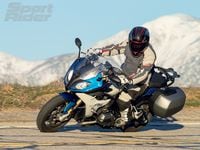
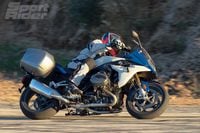
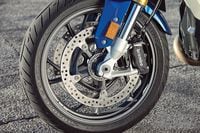
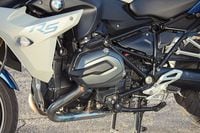
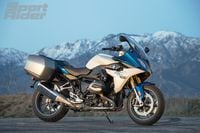
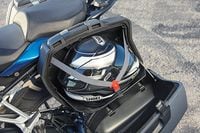
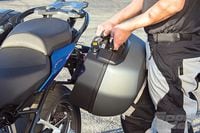
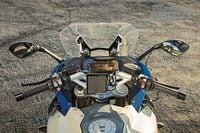

/cloudfront-us-east-1.images.arcpublishing.com/octane/K3R6PGUBF5GS5BDWWZ6FAFIFTU.jpg)
/cloudfront-us-east-1.images.arcpublishing.com/octane/6YTVGET7GJAWRKZFI6FMEUBAHE.jpg)
/cloudfront-us-east-1.images.arcpublishing.com/octane/I7G4VVWN4RHHLHD2PROCYZT5TU.jpg)
/cloudfront-us-east-1.images.arcpublishing.com/octane/3S7JJ3WBO5AC7KKRUX34DI5KQE.jpg)
/cloudfront-us-east-1.images.arcpublishing.com/octane/RO36KTIVYZEATJW7CCB77EQHLQ.jpg)
/cloudfront-us-east-1.images.arcpublishing.com/octane/BUIUXSLF5RFRVJ3E26VRO5V2AY.jpg)
/cloudfront-us-east-1.images.arcpublishing.com/octane/EJJ2JBBSEZAWLFCRDALQOIBFVU.jpg)
/cloudfront-us-east-1.images.arcpublishing.com/octane/WVYKJFMINVFMFH37AE4OUEWVIM.jpg)

/cloudfront-us-east-1.images.arcpublishing.com/octane/JJ3MC6GNDFF5ZNYD3KD3E4EY7Y.jpg)
/cloudfront-us-east-1.images.arcpublishing.com/octane/XH2ETEU4NVGDFNQO2XT2QQS5LU.jpg)
/cloudfront-us-east-1.images.arcpublishing.com/octane/UFG652C27BDBFPK42TDAJ5CMX4.jpg)
/cloudfront-us-east-1.images.arcpublishing.com/octane/AUE3NFVRRZDSBIDVUGIYIDQNUI.jpg)
/cloudfront-us-east-1.images.arcpublishing.com/octane/LYR62CH2WNBMHJJVXVATZHOUE4.jpg)
/cloudfront-us-east-1.images.arcpublishing.com/octane/RBCTRGBQYBDK7A6XPG3HKPS7ZQ.jpg)
/cloudfront-us-east-1.images.arcpublishing.com/octane/MQXQRYMZVBCWJIRYP3HEN3SHVE.jpg)
/cloudfront-us-east-1.images.arcpublishing.com/octane/TSPODNNEWRDSVJGUCNQTDG4ADI.jpg)
/cloudfront-us-east-1.images.arcpublishing.com/octane/X5TB7BDV4BA2RPSY54ZGK27RP4.jpg)
/cloudfront-us-east-1.images.arcpublishing.com/octane/REUHOJXRDBGZ5IHBYZCCBCISPA.jpg)
/cloudfront-us-east-1.images.arcpublishing.com/octane/52LGJTCKBFEHDF7S7H4CVUIMGM.jpg)
/cloudfront-us-east-1.images.arcpublishing.com/octane/YMWAIPIPSJAOXOU3QMJMGH37OM.jpg)


/cloudfront-us-east-1.images.arcpublishing.com/octane/EJ6KZRGAYBCVXNL2PJXL37UVWQ.jpg)